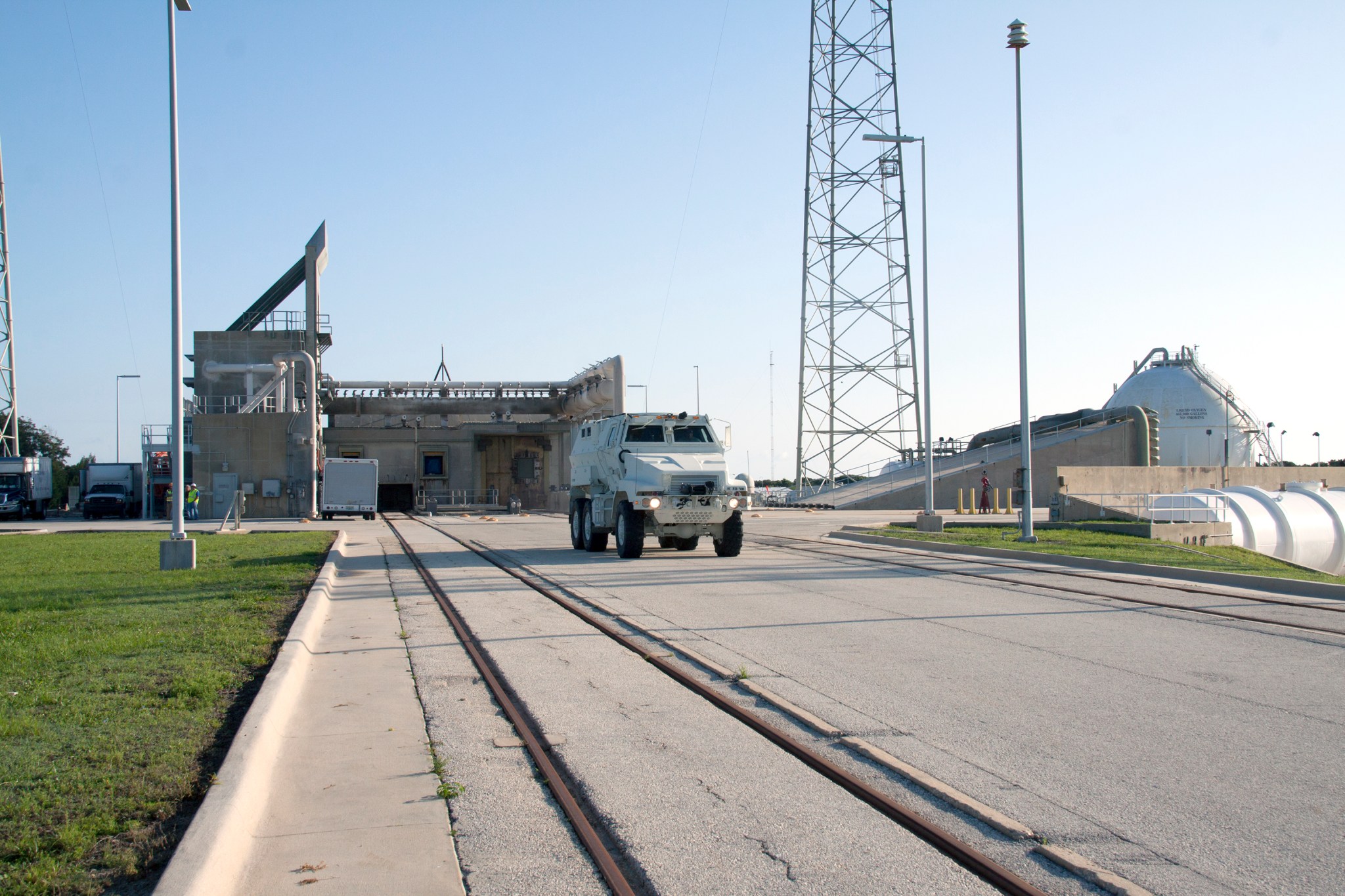NASA has a new set of wheels to get its astronauts and ground operations personnel away from danger at the launch pad and in its first extensive timing tests, the 45,000-pound MRAP armored vehicle showed it’s a bit faster than expected.
Engineers from Boeing and NASA’s Commercial Crew Program, United Launch Alliance and Special Aerospace Service drove the MRAP, short for Mine Resistant Ambush Protected, on potential emergency routes at Space Launch Complex 41 at Cape Canaveral Air Force Station to determine how much time to allocate in their contingency plans for launches coming up in 2017.
The planning is required as Boeing works toward certifying its CST-100 spacecraft for flight tests with and without crew from the launch pad. It will be followed later by more simulations and analysis that will eventually include a full rehearsal with slide-wire baskets carrying astronauts and ground personnel from the top of the crew access tower now under to construction to a spot some 1,300 feet away from the pad. That’s where MRAPs will be parked on launch day.
“We were surprised it was faster than we’d calculated,” said Brian Pitchford, a senior systems engineer for Special Aerospace Services. “It’s not noisy at all, I mean you can carry on fairly regular conversations inside. We’ve pretty much base-lined what we’re going to do as far as evacuating the pad but for the purpose of completeness we wanted to test various routes that could become primary routes or secondary routes.”
Astronauts will climb into vehicles where they can either stay in place protected by the MRAP’s thick hull or start up the wheeled trucks and drive away from potential danger to an area outside the blast danger area or to a helipad where an injured person could be flown to a hospital or other facility.
“Knowing how long it takes to get a person from the pad to where it will be safe is critical in our risk reduction for the crew,” said Steve Payne of Commercial Crew, a former shuttle test director whose launch day responsibilities often included making sure emergency crews and equipment were ready for any countdown and launch situation. “You can draw lines on a map all you want, but until you get out and run the course in real-life conditions, you don’t know. You think you know, but you don’t know.”
The scenario has never played out in real life, but has been planned for since designers started launching humans on top of rockets. A simple crane with a basket was in place for Alan Shepard in case he had to get out of his Mercury capsule in a hurry in 1961, for instance. As the rockets became more robust, planners incorporated faster evacuation methods that included hurried transportation to a bunker for the Saturn V and space shuttle. For shuttle, Vietnam War-era M113 armored personnel carriers waited at the bunker in case astronauts needed to get away fast.
The MRAP’s armor is so thick that each door weighs 600 pounds and has the sound and feel of a bank vault. So the vehicle can function as a bunker on its own, even if it stays put, said Howard Biegler, United Launch Alliance’s project manager for SLC-41.
“It provides some benchmarks and ensures we have the right vehicle for the job and it tells us how quickly we can get out of danger,” Biegler said. “Today, I learned that I don’t want people climbing up the rear end of the MRAP because of the steps, so we’ll design a ramp and they can run up right into the back of it.”
Able to drive smoothly at 45 to 50 mph, the MRAP is also considerably faster than the M113 and can be driven like a truck, which means the demands on an astronaut or support staff would be minimized during a stressful evacuation of the launch pad area.
“I think it’ll be exponentially easier to drive than the M113,” said Tim Moore, an emergency management specialist with Kennedy’s Protective Services who drove the MRAP through the timing runs. “If you can drive a large truck, you can drive one of these.”
Moore worked with the Defense Department to transfer a set of surplus MRAP vehicles for NASA’s Ground Systems Development and Operations Program, which had the vehicles modified and painted white. The transfer was between government agencies, so there was no net cost to taxpayers for NASA to acquire the vehicles, Moore said. NASA will use the vehicles for crew emergency operations for the Space Launch System rocket and Orion spacecraft. The vehicles also are available for commercial launch operations at Florida’s spaceport and Boeing will reimburse the agency for their use.



























